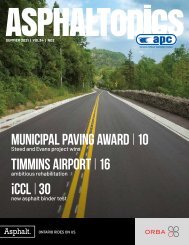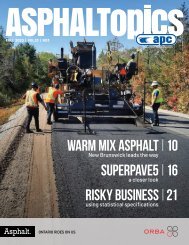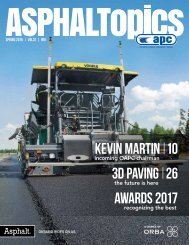ASPHALTopics | Summer 2020 | VOL 33 | NO 2
ASPHALTopics is the official publication of the Ontario Asphalt Pavement Council - A Council of the Ontario Road Builders' Association. Articles within ASPHALTopics may not be republished without express permission from OAPC.
ASPHALTopics is the official publication of the Ontario Asphalt Pavement Council - A Council of the Ontario Road Builders' Association. Articles within ASPHALTopics may not be republished without express permission from OAPC.
- No tags were found...
Create successful ePaper yourself
Turn your PDF publications into a flip-book with our unique Google optimized e-Paper software.
PMAC’s temperature up during transit,
and off-loading stiffened PMAC which
can be hard on pumping equipment and
more susceptible to clogging filters.”
“Ideally, PMAC should be heated higher
than your neat AC to help it flow better
and unload easier,” says Bernal. “Having
AC tankers that hold their heat and having
properly sized pumps at the asphalt plant
helps move the PMAC quicker.”
AT THE WORK SITE
Once PMAC has arrived at the work
site, a similar set of handling and
cleaning issues arise that pavers
have to contend with. It is also equally
important to ensure that the mix is at
the right temperature range for effective
compaction operations.
”The increased stiffness of PMAC will
find weak chains and other worn parts
in MTVs, pavers, and plant drag and
traverse conveyors,” says Schreck. “It
is recommended that clean stone be
run through both at the end of the shift
to clean out any buildup before shutting
down for the day or night. Equipment
must be cleaned and cleared of any
buildup or breakage may occur at
startup the following shift.”
Whatever release agent is chosen, “it
takes 50 per cent longer to clean plant
and paving equipment that has used the
higher polymer mixes,” says Martin. “It
is tough to track how much extra wear
there is on equipment given that plant
and equipment switch back and forth
between PMAC and other materials on
a daily basis.”
There’s also the issue of PMAC sticking
to the rubber tires of rollers and other
vehicles working on the job site which
can damage the newly-paved mat and
the tires in the process. “One way to
reduce this problem is by running the
rubber-tire roller up and down an area
to warm up the tires,” says Bernal. “This
prevents the initial pickup of material at
the start of the paving.”
Proper tire pressure also plays a
role in reducing PMAC pickup. “As a
preventative measure, we have installed
a pressure switch on to the park brake
circuit that will not allow the roller to
move until the rubber tires are at their
proper operating pressure,” says Kollar.
“That is really important.”
“Good roller maintenance matters,” says
Steve Gostis, Paving Product Specialist
with Toromont CAT. “This includes
properly maintaining the skirting on
the machine so that it is a good height
from paved surface, the rubber is
in good condition, the corners fixed
together without gaps, and no tears or
rips; a good working tire spray system;
and monitoring the temperature of the
asphalt to keep an effective working
distance from the paver and breakdown
roller while keeping the tires at the
proper temperature. Cocoa mats and
scrapers, if they are installed, must also
be kept in good working condition.”
Using the right PMAC release agents
in the tire spraying systems certainly
helps. But more can be done. “Tomlinson
has enlarged the fogging nozzles on
the spray systems, installed better
screens on the suction side at the tank,
and installed a high pressure filter after
the pump,” Kollar says. “We have also
installed pressure switches to better
maintain the pressure to the nozzles,
made up quick change mats that ride on
the tires so that the product stays evenly
applied, and ensured the entire system
is cleaned and stays cleaned.”
“Cleaning is a must,” he adds. “We cannot
stress it enough. It is the difference
between PMAC working or failing.”
THE TAKEAWAY
Polymer-modified asphalt cement
delivers an improved product with
an enhanced life expectancy and
performance. While it certainly
presents its own unique challenges,
it’s clear that thoughtful handling
through the production to paving
process can achieve favourable
results with the fewest headaches.
SUMMER 2020 33


















